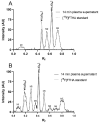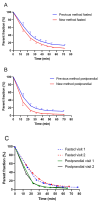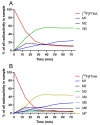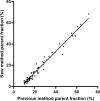New improved radiometabolite analysis method for [18F]FTHA from human plasma: a test-retest study with postprandial and fasting state
- PMID: 38869780
- PMCID: PMC11176130
- DOI: 10.1186/s13550-024-01114-5
New improved radiometabolite analysis method for [18F]FTHA from human plasma: a test-retest study with postprandial and fasting state
Abstract
Background: Fatty acid uptake can be measured using PET and 14-(R,S)-[18F]fluoro-6-thia-heptadecanoic acid ([18F]FTHA). However, the relatively rapid rate of [18F]FTHA metabolism significantly affects kinetic modeling of tissue uptake. Thus, there is a need for accurate chromatographic methods to analyze the unmetabolized [18F]FTHA (parent fraction). Here we present a new radiometabolite analysis (RMA) method, with comparison to a previous method for parent fraction analysis, and its use in a test-retest clinical study under fasting and postprandial conditions. We developed a new thin-layer chromatography (TLC) RMA method for analysis of [18F]FTHA parent fraction and its radiometabolites from plasma, by testing stationary phases and eluent combinations. Next, we analyzed [18F]FTHA, its radiometabolites, and plasma radioactivity from subjects participating in a clinical study. A total of 17 obese or overweight participants were dosed with [18F]FTHA twice under fasting, and twice under postprandial conditions and plasma samples were obtained between 14 min (mean of first sample) and 72 min (mean of last sample) post-injection. Aliquots of 70 plasma samples were analyzed using both methods, enabling head-to-head comparisons. We performed test-retest and group comparisons of the parent fraction and plasma radioactivity.
Results: The new TLC method separated seven [18F]FTHA radiometabolite peaks, while the previous method separated three. The new method revealed at least one radiometabolite that was not previously separable from [18F]FTHA. From the plasma samples, the mean parent fraction value was on average 7.2 percentage points lower with the new method, compared to the previous method. Repeated [18F]FTHA investigations on the same subject revealed reproducible plasma SUV and parent fractions, with different kinetics between the fasted and postprandial conditions.
Conclusions: The newly developed improved radio-TLC method for [18F]FTHA RMA enables accurate parent fraction correction, which is required to obtain quantitative data for modelling [18F]FTHA PET data. Our test-retest study of fasted and postprandial conditions showed robust reproducibility, and revealed clear differences in the [18F]FTHA metabolic rate under different study settings.
Trial registration: EudraCT No: 2020-005211-48, 04Feb2021; and Clinical Trials registry NCT05132335, 29Oct2021, URL: https://classic.
Clinicaltrials: gov/ct2/show/NCT05132335 .
Keywords: Metabolic imaging; Parent fraction; Radio-TLC; Radiometabolite analysis; [18F]FTHA.
© 2024. The Author(s).
Conflict of interest statement
Employments at the time of study: IL by Antaros Medical AB, Mölndal, Sweden; TC, ZM and AH by Eli Lilly and Company. The other authors declare that they have no competing interests.
Figures





References
-
- Rodríguez-Carrio J, Alperi-López M, López P, et al. High triglycerides and low high-density lipoprotein cholesterol lipid profile in rheumatoid arthritis: a potential link among inflammation, oxidative status, and dysfunctional high-density lipoprotein. J Clin Lipidol. 2017;11:1043–54. doi: 10.1016/j.jacl.2017.05.009. - DOI - PubMed
-
- DeGrado TR, Coenen HH, Stocklin G. 14(R,S)-[18F]fluoro-6-thia-heptadecanoic acid (FTHA): evaluation in mouse of a new probe of myocardial utilization of long chain fatty acids. J Nucl Med. 1991;32:1888–96. - PubMed
-
- Stone CK, Pooley RA, DeGrado TR, et al. Myocardial uptake of the fatty acid analog 14-fluorine-18-fluoro-6-thia-heptadecanoic acid in comparison to beta-oxidation rates by tritiated palmitate. J Nucl Med. 1998;39:1690–6. - PubMed
Associated data
Grants and funding
LinkOut - more resources
Full Text Sources
Medical

